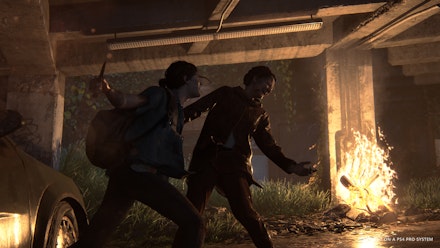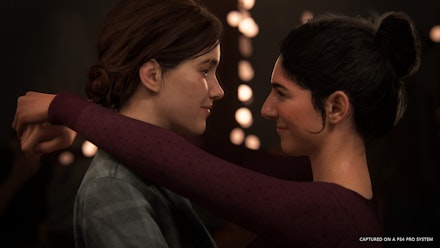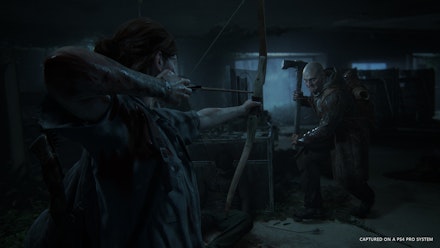The Last of Us Part II was a big risk. The first game arrived in 2013, during the death throes of the Playstation 3. A story of second chances, paternal love, and finding beauty amidst endless horror, it was a singular title that charted a man and girl’s journey across the broken carcass of America, in the wake of a deadly outbreak. Hugely cinematic, artfully told and emotionally resonant, it emerged as the definitive title of the PS3, and the crowning achievement of Santa Monica-based developer Naughty Dog. It was also a game with a near-perfect ending, one that sat with players and weighed upon them long after the experience was over.
The decision to follow on from that is something director Neil Druckmann has clearly not taken lightly. Rather than try to duplicate what worked so well in the first game’s story, he has opted to do something different, and shift the mood entirely. Where the first game was about love, Part II is a story of hate. It is a bleak, challenging, frequently upsetting, emotionally turbulent experience that asks difficult questions and offers answers that are harder still.

Four years after the events of The Last Of Us, nineteen year-old Ellie (Ashley Johnson) and surrogate father Joel (Troy Baker) have settled back in Jackson, Wyoming, as part of the community led by Joel’s brother Tommy (Jeffrey Pierce) and his wife Maria (Ashley Scott). Life is good, punctuated by routine patrols, the occasional barn dance, camaraderie and a real sense of normalcy, despite the apocalyptic outbreak that brought wider society to ruin. Until the attack, that is. Under cover of a blizzard, hunters launch a shocking, harrowingly graphic assault that leaves the community ruptured and broken. Despite entreaties to stay, Ellie leaves Joel behind and sets out on a campaign of bloody revenge.
While Joel still plays a role in the story (as both player character and companion), the perspective switch to Ellie is a significant one — far more so than in the brief segment she took centre stage in the original, or its prequel Left Behind. No longer the mouthy 14-year-old from Part I, she has since grown into a flinty, yet socially-awkward young woman. Hardened by events, she is often brittle and single-minded, but sharp edges alone do not define her. Ellie is warm and relatable, with a tenderness that surfaces often in the nervous exploration of her relationship with Dina (Shannon Woodward), who accompanies Ellie on her journey.
As with the first game, your companion serves a threefold purpose: lending material assistance during combat (Dina’s dead-eye marksmanship saved our hide from flanking foes on more than one occasion), offering advice on how to proceed, and, most importantly, providing character depth. As the pair spend time together, they swap stories, flirt coyly, and navigate the awkward yet intense first steps of a believable love affair. Dina is honest and forthright, sharing tales of failed relationships and memories of life before society’s collapse. Ellie deflects often with snarky humour but, as time passes, begins to lower her guard and open up. It’s a deft and delightful piece of character work, with a distinctly different feel to the spiky banter Ellie shares with Joel, and lending the unfolding story more texture and nuance than its predecessor.

Added complexity isn’t limited to character, either. The game’s stealth/survival gameplay has been honed and refined, a streamlined interface making inventory management less painful, while allowing frantic, mid-combat crafting to be a viable (and often necessary) strategy. The PS4 remaster of the original enhanced the visuals significantly, but the difference in fidelity between that title and this is stark nonetheless. Environments are exquisitely rendered, with an almost absurd attention to detail, from the way ferns brush Ellie’s legs as she walks through the brush, to duckweed parting before her as she swims or the simple way a bracelet slides up her wrist at the raise of an arm.
With most of the game taking place in Seattle, the geography has a more distinctive identity this time around. The hollowed out shell of the seaport city is overgrown and crumbling with rot: a monument of haunting emptiness. It is at once more vast but also more claustrophobic than the cross-country hike Ellie made with Joel. The clash of natural beauty and urban decay forms an environment that is by turns beguiling and deeply sinister, switching mood on a dime at the behest of a simple lighting change or shift in the rhythm of Gustavo Santaolalla’s acoustic score. As you might expect from the Pacific Northwest, the weather plays an important role, too. The sky is frequently overcast, with the patter of constant rain muffling footsteps and leaving the characters sodden and squelching.
The less linear environment offers multiple paths to your various destinations, lending a new sense of freedom. One section early on even takes the form of a mini open world, laying bare a section of the city, with buildings and avenues ripe for exploration or avoidance. There’s a similar sense of liberation found in playing Ellie herself. She is quick, agile and far more adept at traversing the terrain than Joel, giving gameplay a natural fluidity. Ellie can shimmy up ropes and vault over obstacles, sliding into cover; while the ability to go completely prone vastly increases the opportunity for silent kills, as you crawl through undergrowth or beneath cars to gain positional advantage. It all results in a much more flexible combat system, one that allows the seamless shift from stealth to direct action and back again multiple times within a single encounter. Thanks to an expanded crafting system that now includes stun and smoke grenades, explosive arrows and improvised, Coke-bottle silencers, there are near endless new ways to sow carnage. Melee combat in particular feels transformational, with Ellie able to dodge and counter, wreaking bloody ruin with switchblade or hatchet while engaging multiple foes at once.
This is among the most accomplished pieces of storytelling, across any medium, that 2020 has to offer.
The skill trees are similarly expanded, with new ones unlocked as the relevant survival manuals are found. Options are many and varied, offering crafting recipes, stealth enhancements and even new game mechanics, all of which feel far more desirable than the rather basic upgrades from the first game. You’ll need them, too, as enemies are not only more intelligent and adaptable but also more varied. Seattle is home to two main factions: the WLF or ‘Wolves’ and a fanatical religious cult called the Seraphites, or ‘Scars’. The Wolves are paramilitary, with hardware to spare. They deploy dogs, who are not only more observant than their handlers (not to mention more upsetting to dispatch) but can pick up your scent trail no matter how well you hide. The Scars, meanwhile, favour melee weapons and bows, whistling eerie warnings to each other and loosing arrows that cause damage over time until you can find safe refuge to dislodge the shaft. The infected ranks have swollen, too. Runners, Clickers and Bloaters return, while the first game’s canny Stalkers are utilised far more liberally, and we’re introduced to the Shambler: a hulking, bulbous figure that belches corrosive clouds.
Altercations with each of these opponents take on a distinct flavour that will inform your tactics, and are regularly enhanced by the bombastic set pieces for which Naughty Dog has become rightly famous. Whether it’s a desperate torchlit flight through one of the city’s parks, darting between cover while pinned by a distant sniper, a blazing firefight through a residential neighbourhood, or a raging storm that’s as metaphorical as it is physical, these skilfully crafted sequences lend the game a cinematic scope and an intensity that sets the heart pounding.

But The Last Of Us Part II’s greatest achievement isn’t in the variety of enemies on offer or their methods of attack, but in the way they make you feel. Even run-of-the-mill foes behave with an innate humanity, bantering easily with one another, even calling out the names of fallen comrades, grief thick in their cracking voices. Unlike the anonymous foes of other titles, your enemies here are carefully and deliberately humanised, provoking a palpable sense of guilt as you cut a swathe through their ranks. Each successive death begins to weigh upon you, and as Ellie’s hands become progressively bloodier, the game forces you to confront the morality of your actions, to question her course and what she is becoming. Ultimately, to make you feel as much a monster as the mindless infected stalking the city’s derelict ruins.
It’s an incredibly bold move, and one that makes the game increasingly uncomfortable to play. As the story unfolds, you’re forced to face the consequences of your actions, to question tightly held truths that seemed so certain in the heat of righteous fury. It’s to make this point land that the game spares no horror in its application of violence. The unflinching brutality at play here is almost unparalleled, but none of it is gratuitous, and neither is it glamorised. As shocking as the game’s maiming, torture and mutilation unarguably is, it is intended to be so. Never to titillate, but to horrify and underscore the game’s central theme.
None of this would land, of course, if the writing and performances weren’t so sublime. Baker, Johnson, Woodward and other cast members including Ian Alexander (The OA) and veteran voice artist Laura Bailey, deliver incredibly nuanced, big-screen-worthy performances. These are each enhanced by state-of-the-digital-art animation and performance capture that allow the actors’ avatars to convey their most subtle facial expression just as convincingly as flesh and blood.
The less known about the narrative twists and turns going in, the better, but Druckmann and Westworld writer Halley Gross have crafted a singular story in The Last Of Us Part II, one that is by turns terrifying, delightful, overwhelming and traumatic. On its face this is a simple revenge tale, but one so challenging and complex, with a bold, unconventional structure, that it lays bare the myth of moral absolutes. It is a meditation on the madness of grief, on losing yourself in rage, on the depths of despair and the promise of redemption. A masterclass in audience manipulation, it smudges the line between protagonist and antagonist to teach a lesson in empathy, tribalism and the self-devouring futility of cyclical violence. All of which culminates in an ending that, much like the first game’s, will burrow into your brain like a parasite and refuse to be shaken loose.
Arriving, like its predecessor, in the twilight of a console generation, The Last Of Us Part II has managed to pull off the very same feat. But this isn’t only the defining title of the PS4, nor simply the best game of the year. This is among the most accomplished pieces of storytelling, across any medium, that 2020 has to offer — a stone-etched landmark in the history of video games. Managing the almost insurmountable task of surpassing the first game in both ambition and emotional punch, Naughty Dog has set the bar anew. A near-perfect game with emotional depth and heft few cinematic experiences can rival, The Last Of Us Part II was, it seems, a risk well worth taking.
